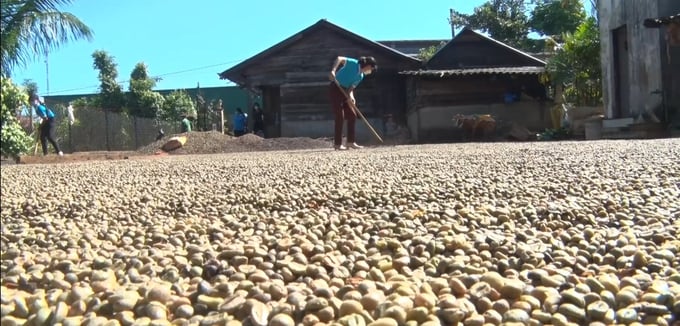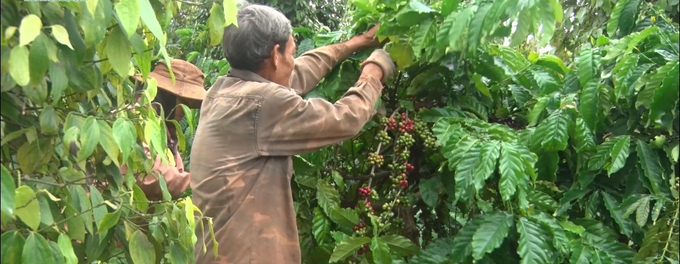May 16, 2025 | 10:20 GMT +7
May 16, 2025 | 10:20 GMT +7
Hotline: 0913.378.918
May 16, 2025 | 10:20 GMT +7
Hotline: 0913.378.918
In recent times, coffee prices have reached record peaks. To have forecasts and analyses about coffee prices in the upcoming 2024–2025 crop year, Vietnam Agriculture Newspaper hosts a talk show with two experts in the coffee industry, who are Mr. Do Ha Nam, Vice Chairman of the Vietnam Coffee - Cocoa Association, and Mr. Nguyen Quang Binh, coffee market analyst.
Dear Mr. Nguyen Quang Binh, we are about to enter a new crop year, and coffee prices are still very high compared to before. So, how long will this high price trend last and why?
Regarding price increase, it is not only thanks to external factors but also sustainable internal factors. The first factor that makes prices go up is output, which is the domestic factor.

Mr. Do Ha Nam (middle), Vice Chairman of Vietnam Coffee - Cocoa Association, and Mr. Nguyen Quang Binh (far right), coffee market analyst, at Vietnam Agriculture Newspaper's talk show "Coffee Exports in the 2024–2025 crop year." Photo: VAN.
According to information from the Vietnam Coffee - Cocoa Association (VICOFA), newspapers, many research agencies, and even the U.S. Department of Agriculture (USDA), Vietnam's coffee output is believed to decrease, especially in the upcoming 2024–2025 period.
Of which, when talking about whether Vietnam's output has decreased or not, it means only talking about the output produced and the output of raw coffee for export, not counting coffee beans consumed domestically or coffee used to process and produce cosmetics and pharmaceuticals. Because if counting, the domestic consumption of coffee beans, such as specialty coffee, is also very large when the specialty coffee using movement in recent years has grown very strongly and many consumers have returned to using specialty coffee and real coffee.
The second factor is foreign markets. Prices have continuously reached records day after day in recent times. However, goods are actually not sold, making farmers not only in Vietnam but also all over the world hesitant to sell.
Europe is now reducing available inventory severely, with a shortage of about 27% compared to last year. The shortage of available coffee inventory occurs when the European Parliament applies a law not to use agricultural products, including coffee, if they originate from deforestation. During this time, many traders want to buy goods quickly to sell to Europe to avoid explaining procedures in the months of November and December. That's why prices have recently increased sharply.

Vietnam's coffee output is believed to decrease, especially in the upcoming 2024–2025 period. Photo: VAN.
Another positive fact for prices is that banks in consuming countries, especially European banks such as the European Central Bank, and the U.S. Federal Reserve have also planned to lower interest rates. Lowering interest rates helps these countries have more credit and capital to buy goods while the inventory is low. Therefore, in the coming time, there will be purchasing power to help prices stand firm. In my opinion, product prices will stay high, but it will be difficult to reach record peaks like in recent times.
As Mr. Binh just shared, the story of rising coffee prices still creates hesitation for farmers around the world. Returning to the story of growers, in early 2024, many coffee growing areas in the Central Highlands and Southeast were affected by prolonged drought. How will this impact Vietnam's coffee output in the 2024–2025 crop year, Mr. Do Ha Nam?
It can be said that the influence of weather on coffee trees is real and not slight. Especially in some areas, such as Dak Lak and Dak Nong, at the time when coffee trees are flowering and fruiting, there is a serious lack of water, and the drought is very severe. After that point, too much rain caused impacts on the crops. Therefore, in areas of Dak Lak and Dak Nong, and some areas affected by drought, output decreased quite a lot.

Farmers intercropped coffee trees with other crops. Photo: VAN.
Meanwhile, in some more stable regions, such as Lam Dong or Gia Lai, output is assessed as stable, even possibly increasing. In addition, with very high coffee prices, farmers tend to increase their investment and care, so it will be very convenient for increasing output in these favorable areas.
However, it is currently known that the coffee tree is not the crop bringing the highest value among agricultural crops. So in recent years, when coffee prices were still relatively low, farmers began to convert coffee trees to other crops, especially durian. Additionally, in the past, farmers intercropped, but now, some major durian-importing countries require specialized farming areas, not intercropping areas.
This forces farmers to cut down coffee trees to select crops with higher value. Therefore, we assess that it is difficult for coffee to expand and develop in the long term because coffee is a sustainable crop but not the one that brings the highest income.
Due to the above-mentioned objective and subjective factors and characteristics of business in the world, I think next year, prices will be stable. However, I also agree with Mr. Binh that it may not be the peak price like last year but will be more stable and also beneficial for farmers. Thus, we hope that the upcoming crop will also be a successful crop for Vietnam's coffee industry.
Thank you, sir!
Translated by Thu Huyen

(VAN) Japan's efforts to lower the price of rice through the release of its stockpile may finally be making some progress, albeit at a snail's pace.

(VAN) U.S. tariffs are not only a 'shock', but also an opportunity for Vietnamese businesses to renew their mindset toward comprehensive development.

(VAN) As Bac Giang lychee enters the harvest season, Minister Do Duc Duy expects that the fruit will contribute greatly to agricultural exports due to standardized production and deep processing.

(VAN) Consumers have shown a preference for free-range eggs, but those farming systems are more vulnerable to biosecurity risks like bird flu.
/2025/05/09/5701-1-184335_301.jpg)
(VAN) Vietnam’s eel exports nearly doubled thanks to a mud-free farming model, opening up new prospects while still facing numerous barriers related to international standards.

(VAN) Minister Do Duc Duy warned that if production is not professionalized and supply chains are not transparent, the U.S. market could become a growth bottleneck.

(VAN) Delegating surveillance responsibilities to local authorities is a cost-saving and efficiency-boosting measure that removes a key bottleneck for enterprises, according to Director General Duong Tat Thang.